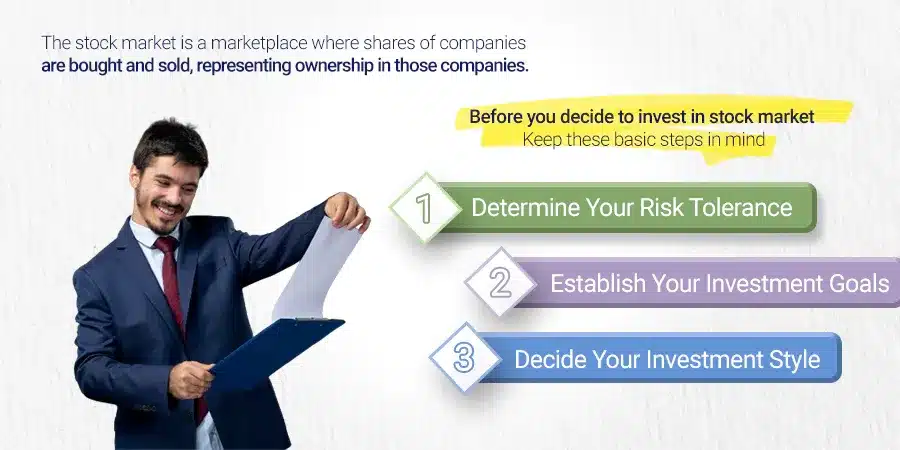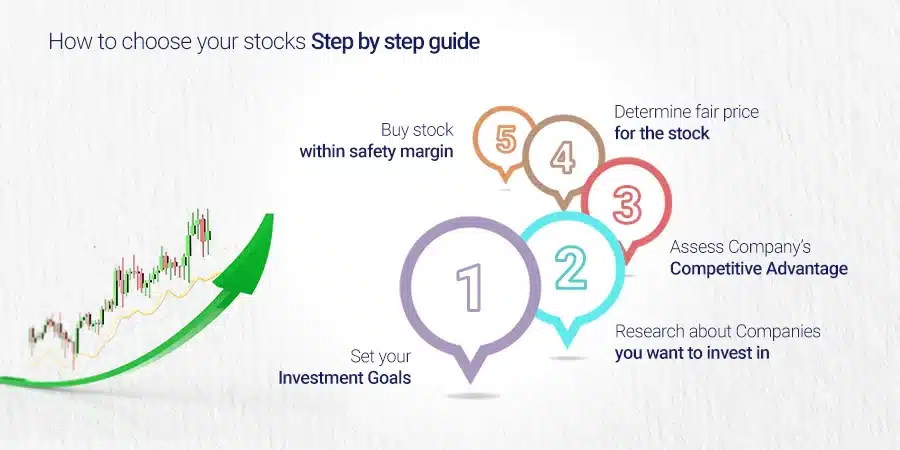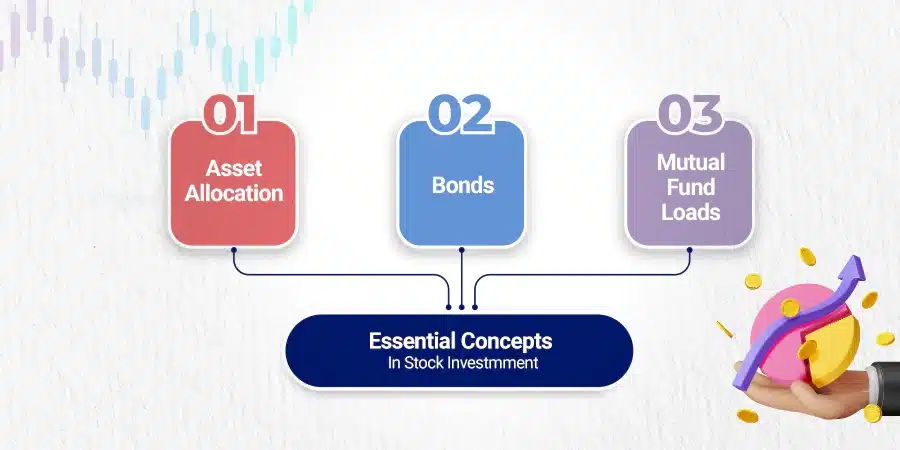Are you looking to grow your wealth but feel overwhelmed by the stock market? You’re not alone; investing in stocks is a powerful way to build wealth, yet many people find it daunting.
This easy-to-read guide for beginners simplifies seemingly complex concepts into easily digestible bites, helping you dip your toes into stock investing with confidence.
Ready for financial growth? Let’s dive in!
Key takeaways
●You can grow your money by investing in the best stocks.
●To invest for the long term, you need to know your risk level and set clear goals.
●When choosing where to invest, look at the costs and what each broker offers.
●Keep an eye on how well your stocks are doing. Also, try investing a little bit of money on a regular basis.
●Fees like commissions may apply when buying or selling stocks.
Understanding the Stock Market
The stock market (also known as the stock index) is like a big shop for shares of firms. To invest in stocks, you need to learn about this big shop.
People buy and sell parts of companies there. These parts are called “stocks” or “shares”.
So, the stock market helps people to trade stocks.
Here’s how it works: A company sells stocks to get money. It uses that money to grow its business. If the company does well later on, then its stocks cost more money.
This makes anyone who owns those stocks richer too! But be careful – if the company doesn’t do well, their shares can lose value too! That means some risk comes with buying any kind of stock from any firm in the market.

How to Get Started in Stock Investment
To begin with, stock investments, determine your risk tolerance. Next, establish clear-cut investment goals tailored to your financial needs and future aspirations.
Decide on an investment style that suits you best; it could be either passive or active investing depending on your preference.
These foundational steps are crucial to laying a solid groundwork for success in the world of stock market investing.

Determining Your Risk Tolerance
You must gauge your risk tolerance when investing in stocks. This tells you how much market ups and downs you can stand.
Risk tolerance is shaped by age, investment goals, and past experiences in investing. And have an investing strategy, especially during market volatility.
Before investing, check your risk tolerance level; this guides your choices. A good understanding of risk tolerance helps drive smart decisions to build a strong investment portfolio.
Establishing Your Investment Goals
You need a plan when you buy individual stocks. Set goals before you start, so you know where your money invested goes.
You may want to save for college costs or create an emergency fund. Goals can be short-term or long-term depending on what you want for yourself and your family.
Keep the future in mind when setting goals and planning how to reach them.
Deciding Your Investment Style
Deciding your investment style is a vital step. You might be an active investor or a passive one. Active investors make many trades.
They try to beat the market and earn more money right away. Passive investors buy many stocks and keep them for a longer time.
They hope their value will grow over time, which can lead to wealth growth in the long run. Both styles have pros and cons, so pick what fits best with your goals and risk level.
- High Returns
- Diversification
- Dividend Income
- Ownership
- Liquidity
- Accessibility
- Tax Advantages
- Missed Growth
- Inadequate Savings
- Lost Opportunities
- Risk Aversion
- Limited Wealth
- Dependency
- Reduced Flexibility
Different Ways to Invest in the Stock Market
Dive into the diverse investment methods in the stock market, from full-service brokers to discount brokers and robo-advisors, each with unique benefits tailored for varying investor types.
Learn more about these options and identify which suits your individual investing style best.

Full-Service Brokers
Full-service brokers help guide you in the stock market. They can make a plan for your money and give advice on how to grow it. You have to pay them a fee for their help.
Their services are great if you’re new to investing or if you’ve been doing it for a while. They offer many ways to invest your money in stocks, bonds, and other options.
Whether you want advice or portfolio management, full-service brokers can be an excellent choice. They work hard to understand what’s best for each client and use that information when choosing investment accounts.
Discount Brokers
Discount brokers help with buying and selling stocks. They cost less than full-service brokers. The services they offer are not the same though.
You can’t get a guide on investing from them like a full-service broker would give you. Yet, you get tools to buy and trade shares by yourself online.
Some even have no minimum balance rule so anyone can start investing, even if they don’t have much money to begin with!
Robo-Advisors
Robo-advisors are the future of stock investing. They do all the hard work for you. You set up your goals and let them go to work.
Robo-advisors use fancy computer programs. This helps them manage your stocks in smart ways.
People like robo-advisors because they don’t cost a lot of money, not as much as human advisors anyway! Also, it does not take too long to open an account with a robo-advisor, so even if you’re new or don’t have lots of cash on hand, this could be helpful to choose to invest in stocks easily and fast without any trouble or delay.
Opening an Investment Account
Opening an investment account is a crucial first step in entering the stock market. This involves selecting from different types of accounts, such as Individual Retirement Accounts (IRAs), taxable brokerage accounts, or education savings accounts.
Ensure you understand the various features and costs associated with each type before making your decision. Reduced trading fees or tax benefits may make one option more appealing than another based on your individual circumstances.
After deciding the suitable type, you can open an account with online brokers or robo-advisors within minutes to start investing in stocks. When opting for human financial advisors, requires extra time as you might need to go through interviews before finalizing your choice.
Types of Accounts
There are many ways to open an investment account. You might choose a human financial advisor, a robo-advisor, or manage it yourself online.
With a human advisor, you get help with making your stock portfolio and planning for more wealth.
But this often comes with fees.
A robo-advisor is another way to go about it. This kind of account uses computers to watch over your money at less cost than the first choice. The third type is self-managing accounts from online brokers that let you buy stocks, bonds and other investments by yourself.
Now it’s clear that not all brokers are the same and each one has different rules in place. So do some homework on which broker will work best for you!
Comparing Costs and Features
The process of comparing costs and features between different investment platforms is crucial in selecting the most appropriate account. It essentially comes down to weighing the overall costs, accessibility, tools, and services each offers.
Broker | Commission | Minimum Deposit | Account Maintenance Fee | Features |
Full-Service Brokers | High | High | Yes | Personalized investment advice, portfolio design, and wealth planning. |
Discount Brokers | Low | Low or None | No | Online platforms to trade and research, but limited advice options. |
Robo-Advisors | Low | Low or None | No | Automated portfolio management, lower costs, and ease of access. |
The table above offers a quick comparison of the costs and features associated with full-service brokers, discount brokers, and robo-advisors.
Each offers unique benefits and costs. Full-service brokers offer personalized services but at higher costs, while discount brokers and robo-advisors offer more affordable options with varying levels of service and automation.
In the end, the choice comes down to one’s investment style, requirements, and budget.
Basic Concepts in Stock Investment
In this section, we’ll explore essential concepts such as asset allocation, where you diversify your portfolio across different investment types for risk management.
Next, we split bonds into categories and explain their role in balancing investments. Finally, we grapple with the term ‘mutual fund loads’, demystifying its significance to a potential investor’s choice of mutual funds – they can be an extra charge or commission that should factor into your decision-making process.

Asset Allocation
Asset allocation helps in managing risk. This idea is about putting your money in different places. You balance where you put it by picking a mix of stocks, bonds, and cash that matches your goals.
The right mix depends on a few things like how much risk you feel okay with and when you need the money back. Robo-advisors and human financial advisors can offer help to figure out this mix for you.
It’s a key task in growing your wealth and reaching your money goals!
Bonds
Bonds are bits of debt. They are loans that people give to others. Most often, companies or the government get these loans.
When you buy a bond, you’re lending your money to them. The loan is for a set time and they must pay you back. You also get paid interest on the total amount you lent out.
Bonds carry risks but can help protect your cash against drops in the stock market.
Mutual Fund Loads
Mutual fund loads are like a cost you pay. They can happen when you buy or sell shares in a mutual fund. There are two types: front-end and back-end loads.
Front-end means that some of your money is taken out at the start, right when you put it into the mutual fund. Back-end happens when you decide to take your money out from the mutual fund, and then part of it gets taken away as mutual fund fees.
How to Choose Your Stocks
Picking stocks may seem hard, but it’s easier if you follow some steps. First, think about your goals. Are you saving for retirement or a big purchase? Your answer will help figure out which types of companies to buy from.
Look at strong companies with a good track record. Don’t pick ones that owe a lot of money or whose stock is too pricey compared to what they earn – this means the company might be overvalued.
You can use online brokers to help find these details and make your choice easier!
Managing Your Stock Investments
Keep your investments in check through portfolio review and continual investing—learn how to strategize, schedule your reviews, and shield yourself from market dips.
Navigate this vital part of the stock investing journey efficiently as you read further!
Setting Up a Portfolio Review Schedule
Create a plan to check your stocks. This is called a portfolio review schedule. It helps you keep track of how your stocks are doing.
You might decide to do this every month, or maybe twice a year. Use the time to look at changes in each stock’s price and profit.
Also, think about any news that impacts the company or its business area. After checking everything, decide whether it makes sense to buy more shares or sell some off.
Continual Investing
You should not stop investing money in stocks. Keep doing it all the time. This is “Continual Investing”.
With this, your wealth can grow more over time. It works best when you set aside a certain amount of money regularly for buying stocks.
This could be each week or every month. Using this method, sometimes you will buy when prices are low and sometimes when they are high.
But overall, it evens out in the end with gains from good times covering losses during bad ones.

Understanding Commissions and Fees in Stock Investing
In stock investing, you may need to pay some fees. These can include commission fees that brokers charge for each trade. For most people, this cost is up to around $10 per trade.
So, trading a lot means spending more on these fees. There are other costs too. Some types of stocks, like exchange-traded funds, come with extra fees.
The reason is they cover the price of managing the fund itself. Different brokers apply different charges and rules as well.
This is why it’s key to look into many options before making any plans about where to invest your money.
Investing in Different Types of Stocks
Understanding the difference between common stock, preferred stock, and penny stock is essential. Common stocks offer voting rights while in contrast, preferred stocks come with no voting rights but a higher claim on earnings and assets.
Penny stocks are relatively risky as they’re issued by small-scale companies with highly volatile prices. Each type caters to different investment goals and risk tolerances; hence it’s vital to analyze your financial strategies before investing.
Market trends plus individual company performance greatly influence the profit margin achievable when one invests in these different types of stocks.

Stock mutual funds or exchange-traded funds
Mutual funds let you purchase small pieces of many different stocks in a single transaction. Index funds and ETFs are a kind of mutual funds that track an index; for example, the S&P 500 fund replicates that index by buying the stock of the companies in it.
When you invest in a fund, you also own small pieces of each of those companies. You can put several funds together to build a diversified portfolio of stocks. Note that stock exchanges fund is also sometimes called equity mutual funds.
Common Stock
Common stock is one kind of share you can buy in a company. It lets you get money when the company does well. The more stocks you own, the more money you can make.
But if the company does not do well, your stock funds may lose value. The price of common stocks always changes.
This happens due to many things like how much people want to buy them or what’s happening with the firm itself. Some kinds of common stocks also let owners vote on decisions for the company.
Different types might have different rules about voting and dividends.
Preferred Stock
Preferred stock is a type of stock you can buy. It can give you special rights that common stocks don’t have. This kind of stock pays out set amounts called dividends to the people who own them.
They move less in price and do not change much like how common stocks do. The two types may trade at different prices on the market too. Not all preferred stocks let you vote in company issues, unlike most common stocks.
Penny Stock
Penny stock is a type of stock you can buy at very low prices. These stocks often cost less than $5 each. Yet, they come with high risks and may change in value quickly due to their unstable nature.
Often, small companies that are not well-known issue these kinds of stocks. They don’t sell on big stock markets but are up for grabs on over-the-counter (OTC) markets instead.
It’s wise to move carefully when thinking about putting money into penny stocks. Always aim to have a mix of different types of investments in your portfolio for safety.
Risks Associated with Stock Investing
Investing in stocks comes with various risks such as stock volatility risk, economic and business risk, inflation risk, and interest rate risks.
You should pay attention to these potential pitfalls before investing your hard-earned money into the stock market. Stock price volatility can greatly affect the value of your investments.
Economic changes likewise have a direct impact on stocks. Factors such as political turmoil, energy issues, or weather disruptions can drastically alter business operations thereby affecting stock prices.
Also worth noting is how inflation and fluctuating interest rates can negatively impact your return on investment through capital loss or reduced purchasing power respectively.
Stock Volatility Risk
Stock prices can go up and down often. This rise and fall of stock prices is called stock volatility risk. It happens due to changes in the market.
These changes could be because of new laws, big news events, or shifts in how people feel about investing.
There are many things you need to think of when dealing with this risk. One way to deal with it is by buying stocks during times when the price dips low.
Then, you hold onto them until their value goes back up again before selling them off at a profit. But remember, this needs patience and a strong gut as there’s no surety when the values will rise again.
Economic and Business Risk
Stocks can fall due to bad news or a weak economy. This is known as economic and business risk. For example, high gas prices hurt transportation companies in the stock market.
Also, rising interest rates make it hard for businesses to get money during inflation. Changes in how people feel about investing can lead to stocks performing differently in the market.
Even media buzz can push up stock prices for growth companies in the market. Lastly, shifts in analyst ratings may change a stock’s price on the market too.
Inflation Risk and Interest Rate Risk
Investing in stocks can have risks. Two big ones are inflation risk and interest rate risk. Inflation risk is when money loses value as prices go up.
This means the same amount of money buys less over time. Interest rate risk is about how changes in rates affect investments. When rates go up, the cost to borrow goes up too.
This can hurt businesses and their stocks may lose value because of it. A better investment strategy like spreading your money across different types of investments helps manage these risks.
Conclusion
Stock market investing can grow your wealth over time. All the advice about investing in stocks for beginners doesn’t do you much good if you don’t have any way to actually buy stocks. Learn about stocks and make smart choices.
Start by choosing the right way to invest in stocks that fit you best. The key to building wealth is to add money to your account over time and let the power of compounding work its magic. Happy investing!
FAQs
Investing in the stock market means buying stocks, or shares, of a company to earn money. You can make profits from rising stock prices and dividends.
To begin with, you need an online brokerage account. This is where you buy your different types of stocks through online stock brokers for beginners.
A financial advisor or robo-advisor can help manage your stock portfolio professionally. Use diversification in investment for wealth planning and long-term growth too!
Yes, the risk may vary based on factors like interest rates, investor demand, and political uncertainty affecting the market price volatility.
They include bond purchases which have stable returns compared to common stocks; alternatively, consider acquiring mutual Funds or ETFs (exchange-traded funds) which contain various assets including both common & preferred shares while delivering stable dividend payments.
Look out at their long-term track record such as corporate profits trend; check if valuations justify present price using Price-earnings ratio thereby avoiding overpriced/overvalued Stocks principle: “low-buy high-sell.”









